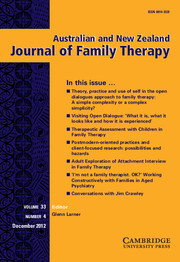Article contents
Theory, practice and use of self in the open dialogues approach to family therapy: A simple complexity or a complex simplicity?
Published online by Cambridge University Press: 28 January 2013
Abstract
In the family therapy literature there is increasing interest in the dialogical approach, particularly as it becomes well-grounded in psychotherapy research. One embodiment is ‘open dialogues’, which has developed over a 30-year period in Western Lapland, Finland. This paper outlines my experience of visiting Keropudas Hospital in Tornio, Finland, the birthplace of open dialogues. It explores the seven theoretical principles of open dialogues, associated elements of clinical practice, and the therapist use of self. The author utilises these aspects to reflect on dialogical moments through words and images based on three conceptual themes, which illustrate the relevance of open dialogues for family therapy practitioners and their contexts.
- Type
- Articles
- Information
- Australian and New Zealand Journal of Family Therapy , Volume 33 , Issue 4 , December 2012 , pp. 266 - 282
- Copyright
- Copyright © The Authors 2013
References
- 11
- Cited by




